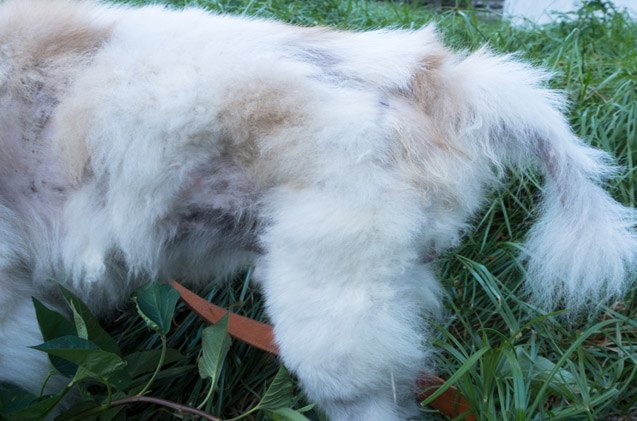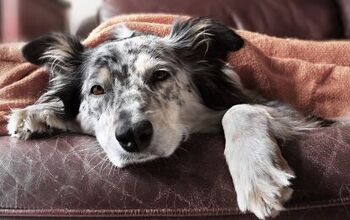The Symptoms, Causes, and Treatments of Alopecia in Dogs

As your puppy grows up, you may notice changes in his coat. If, however, your dog starts to lose patches of fur or if his coat seems to be thinning all over, it could be a sign of a problem – it could be alopecia. Alopecia is simply the medical term for hair loss and, in many cases, it is a symptom of an underlying condition. Keep reading to learn more about alopecia in dogs.
What Causes Alopecia in Dogs?
Though it most commonly refers to hair loss, alopecia actually covers a variety of changes to a dog’s coat including failure to grow or overall thinning. The most common cause for alopecia in dogs is an underlying medical condition such as Addison’s disease, hypothyroidism, allergies, or cancer.
Related: What Causes Hair Loss In Dogs?
Depending on the underlying cause, alopecia can be either gradual or acute – this simply means that it may come on slowly and worsen over time, or it may seem to happen all at once. Regardless the cause, alopecia is usually very noticeable in dogs, though it takes different forms such as bald circles or all-over hair loss. It may also be accompanied by inflammation or crusty, scaly skin.
There are many different causes for alopecia in dogs but the most common is mange – this is a condition caused by Demodex mites. A dog may also develop alopecia when the normal growth of hair is interrupted by something like an infection, trauma, immune disease, or hormonal abnormality. In cases where you notice multiple patches of hair loss, it may be due to inflammation of the hair follicles that leads to a disruption of hair growth. More widespread hair loss usually indicates some kind of disease such as ringworm or a bacterial infection.
Can Alopecia Be Treated?
The best treatment for alopecia can only be determined by the underlying cause. If the root cause is a bacterial infection, medicated shampoos or topical ointments may be beneficial. If alopecia is caused by an underlying condition like hypothyroidism, that condition needs to be treated first and, hopefully, the alopecia will resolve itself.
Related: What Is Mange In Dogs?
Because there are so many potential causes for alopecia in dogs, you need to have your vet diagnose the cause before you try any treatments. If you try an antibiotic ointment and the cause for the alopecia is hormonal, for instance, the treatment won’t work, and you could actually cause other problems for your dog. Do yourself and your dog a favor by getting an accurate diagnosis first and then start a course of treatment.
Once you have restored your dog’s coat to health, it is important that you maintain that health with proper grooming habits. Brush your dog at least a few times a week, depending how heavily he sheds. Not only will regular brushing help to reduce shedding, but it will also help to distribute the natural oils produced in his skin that help to keep his coat healthy. Avoid over-bathing your dog because you could dry out his skin and coat, and don’t use any products that aren’t approved for dogs.

Kate Barrington is the loving owner of two cats (Bagel and Munchkin) and a noisy herd of guinea pigs. Having grown up with golden retrievers, Kate has a great deal of experience with dogs but labels herself a lover of all pets. Having received a Bachelor's degree in English, Kate has combined her love for pets and her passion for writing to create her own freelance writing business, specializing in the pet niche.
More by Kate Barrington























